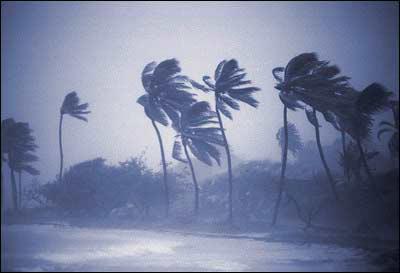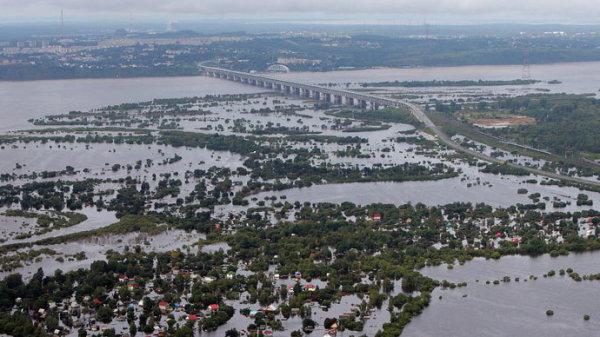Abstract on the topic:
Moderate monsoon climate
Plan:
- Introduction
- 1 North hemisphere
- 2 Southern Hemisphere
Introduction
Moderate monsoon climate- type of climate according to Alisov's classification, typical for East Asia(Russia: Khabarovsk, Primorsky Krai, Sakhalin Region; North-east of China, DPRK; Japan: Hokkaido, northern Honshu), as well as for Canada (Nunatsivuit) and Argentina (Patagonia)
1. Northern Hemisphere
In eastern Asia, this climate is typically monsoon. Monsoons temperate latitudes are here a continuation of tropical and subtropical monsoons, they are very clearly expressed and are observed approximately up to the latitude of Northern Sakhalin. The south of Kamchatka is free from them, and over Sea of Okhotsk and over the north of Kamchatka only a monsoon tendency is found. Thus, a moderate monsoon climate is observed in the Primorsky Territory, in northeastern China, in northern Japan and on Sakhalin.
In winter, the outskirts of the continent are on the periphery of the Asian anticyclone, and here the transport of cold air from Eastern Siberia... Therefore, winters here are slightly cloudy and dry with significant cold and a sharp minimum of precipitation. In summer, cyclonic activity with fairly abundant precipitation dominates over eastern Asia. For example, in Khabarovsk average temperature in July + 20˚С, in January -23˚С; average annual amount precipitation is 560 mm, of which 74 mm fall in the winter half-year (October - March). The situation is more complicated in Japan, where cyclones with frontal precipitation are quite frequent in winter, which is further intensified by orography. In summer, on the contrary, there is a relative minimum of precipitation in the middle of the season due to the retreat of cyclonic activity to the north. As a result, winter can be as rich in precipitation as summer. In Sapporo, the average temperature in August is + 21˚C, in January -6˚C; precipitation 1040 mm per year, with 540 mm in the winter and 500 mm in the summer.
In the northern regions of the Russian Far East, where the monsoon wind regime is weak or absent, winter, due to strong cyclonic activity, is milder and the distribution of precipitation is uniform throughout the year. So, in Klyuchevskoy in Kamchatka, the average temperature in July is + 15˚С, in January -18˚С; precipitation is 460 mm per year, with 210 mm during the winter half-year.
On the Atlantic coast of Canada and Newfoundland, the monsoon circulation is weak or absent. Winters are not as cold here as in eastern Asia, summers are quite warm. For example, in Halifax the average temperature in July and August is + 18˚C, in January -4˚C; precipitation is 1420 mm per year, and the seasonal distribution is fairly even.
2. Southern Hemisphere
V South America to the eastern part of the continent in temperate latitudes, the entire Patagonia can be attributed, from about 38˚ to 52˚ S. NS. and from the foothills of the Andes to Atlantic Ocean... The peculiar geographic setting creates here a peculiar semi-desert climate in close proximity to the ocean. The reason is that from the influence of air sea masses with The Pacific Patagonia is closed by the Andes. At the same time, cold air masses of Antarctic origin freely penetrate here from the south. Atlantic air, occasionally invading Patagonia, preliminarily passes over the cold waters of the Forkland Current, where it receives stable stratification, and therefore also does not give large precipitation.
In most of Patagonia, the annual precipitation is 120-200 mm, and in the summer months there are very few of them, no more than 20-30 mm in three months. The average January temperature is from + 20˚C in the north to + 10˚C in the south, that is, the summer is cold compared to the deserts of the northern hemisphere at the same latitudes. The average temperature is close to + 5˚С, but at high plateaus it drops to -5˚С; therefore, the winter is much milder than in the extratropical deserts of the northern hemisphere. On the low coast of the Atlantic Ocean in the south of Patagonia, in Puerto Santa Cruz, the average temperature in July and June is + 2˚C, in January + 15˚C; precipitation 140 mm per year.
This abstract is based on an article from the Russian Wikipedia. Synchronization completed 07/11/11 04:22:25 AM
Similar abstracts:
The climate on planet Earth is very diverse. Somewhere it rains almost every day, but elsewhere there is no shelter from the heat. And yet, weather conditions obey their own laws. And just by looking at the map of the world, a specialist with a high degree of confidence will be able to say which one at one point or another the globe climate. Did you know that, for example, in Russian Far East and in India one and the same Amazing but true.
Monsoon climate on planet Earth
So what are the main features of this type? Well, firstly, the monsoon climate is typical for those areas of our planet where A change occurs on a more global scale in winter and summer - the movement of the Monsoon is a wind that generally blows from the mainland in winter and from the sea in summer. But it often happens the other way around.
Such winds can bring both heavy rainfall and stifling heat. Therefore, the main feature monsoon climate is an abundance of moisture in summer and its almost complete absence in the cold season. This distinguishes it from other types, where precipitation is distributed more or less evenly throughout the year. There are, however, places on Earth where this is not so obvious. In some areas of Japan, for example, the climate is also monsoon. But due to the geographical position and the features of the relief, it rains there almost all year round.
In general, the monsoon climate is common only at certain latitudes. As a rule, these are subtropics, tropics and For temperate latitudes, as well as for equatorial zones, it is not typical.
Varieties
Mainly because of the terrain and latitude, the monsoon climate is usually divided into several types. And, of course, each of them has its own characteristics. Moderate monsoon climates are found in China, North Korea and partly in Japan. In winter, there is little precipitation in this area, but it is rather cold due to air masses from Eastern Siberia. There is more moisture in the summer. But in Japan it is the other way around. the coldest month in the region is minus twenty, and the warmest is +22.
Subequatorial
Distributed mainly in the Indian and western Pacific oceans. In addition, the climate of the tropical monsoons (as it is also called) occurs at the corresponding latitudes of Africa and in southern regions Asia and America. It is as warm here as in the tropics.

The subequatorial climate of the tropical monsoons is subdivided into several subtypes. All of them belong to the corresponding zones of the Earth. So, this is continental, oceanic, as well as monsoons of western and eastern shores... The first subtype is distinguished by a sharp difference in precipitation over the seasons. In winter, they are practically absent, and in summer there is almost an annual rate. The African states of Chad and Sudan can be cited as examples.
The oceanic subtype of tropical monsoons is characterized by an insignificant amplitude of both annual and daily temperatures. Typically, it is 24 to 28 degrees Celsius. The dry period in these places does not last long.
The monsoons of the western shores are Indian and West African. In the dry season, there is also almost no precipitation, but in the rainy season, there is simply an abnormal amount. This happens, for example, in some places in India. And Cherrapunji receives the largest amount of precipitation in the world - twenty one thousand millimeters!
In this climate, the course of annual temperatures is also unusual: their maximum occurs in spring.

The monsoon of the eastern shores also has a long rainy season. However, maximum moisture occurs in late summer or September, as in Vietnam, where only seven percent of precipitation falls in the dry season.
The monsoon climate of the Far East
Basically, such conditions exist in the Khabarovsk and Primorsky Territories, as well as on Sakhalin. Winter in these places is dry: it accounts for 15 to 25 percent of the annual rainfall. Spring also doesn't bring much rain.
In summer, the monsoon from the Pacific Ocean prevails. But it only affects the climate of the coastal regions.
In the lower reaches of the Amur, winter is, on the contrary, snowy, the average temperature is minus 22. Summer is also not hot: within plus 14.
Winter is harsh on Sakhalin, but in the south-west of the island it is much warmer due to Sea of Japan... Summer is cool.
In Kamchatka, January temperatures range from -18 to -10 degrees Celsius. The same can be said about July: from +12 to +14, respectively.

Monsoons have a significant impact on the climate of many regions of the planet. It is impossible to say unequivocally whether it is positive or negative. However, people should always be prepared for weather surprises inherent in this type of climate. Perhaps in the future we will have to deal more often with such manifestations as, for example, the Amur spill.
And all year round, the Arctic air masses... Because of geographic location the territory has very little. In winter, under polar night conditions, the surface receives practically no solar heat and the average is about -30 °. Most low temperatures are noted in the eastern part.
V summer time The sun does not set over the horizon, however, the angle of incidence of the rays is small. In this case, most of the radiation is reflected by the surface of the snow. In addition, the heat is spent on melting snow and ice. Thus, the average temperature of the warmest month in most of the territory is close to 0 °.
Because of its low temperature, arctic air is unable to contain much. Therefore, in spite of the insular and coastal position of the territory, there is little precipitation - from 100 to 200 mm. But even such a small amount of moisture is not able to evaporate, and the territory is characterized by excessive moisture(K> 1).
Subarctic climatic zone. Subarctic climate.
The subarctic type of climate is typical for the peninsulas. In the European part of Russia southern border The spread of this type of climate runs along the Arctic Circle, and in the Asian part it drops to the south to 60 ° N. NS. Moderate air masses dominate in summer, and arctic ones in winter.
Winters are as cold here as in the arctic climate zone. However, summer is warmer. Average July temperatures are positive and vary from + 4 ° in the north to + 12 ° in the south.
Compared to approximately twice (200-400mm), the amount of precipitation also increases. Their summer maximum is more pronounced. The annual amount of precipitation exceeds the amount of evaporation and moisture is excessive.
Moderate climatic zone. Moderate continental climate.
Typical for the European part of the country. As a result of the western transfer of air masses of this territory, air masses regularly reach from. The ocean heats up more slowly and cools down more slowly. In this regard, winter temperatures are not as low here as in the Asian part. At the same time, in the west it is warmer in winter -4 °, and in the east it is colder - up to -20 °. Thaws occur during all winter months due to invasions of the Atlantic air.
Summers are warm, average July temperatures vary from + 12 ° in the north to + 24 ° in the south. In accordance with this, the evaporation rate increases from north to south from 400 to 1000 mm.
Annual precipitation decreases when moving from northwest to southeast from 800 to 250 mm. As a result, the moisture conditions are not the same: in the north - excessive, in the central part - sufficient, in the south - insufficient.
Moderate climatic zone. Continental climate.
Continental climate temperate zone distributed in central and southern parts West Siberian Plain... The influence of the Atlantic Ocean is less noticeable here compared to the European part. This leads to a decrease annual quantity precipitation, lowering winter temperatures, increasing annual amplitude temperatures.
In most of the territory, the annual amount of precipitation is approximately equal to the evaporation rate.
Moderate climatic zone. Sharply continental climate.
Sharp continental type climate has formed for the most part. The inland position of the territory determines the dominance of the continental air. The oceans do not "prevent" the territory from being very hot in summer and cooling in winter.
Average January temperatures are from -28 ° to -48 °, that is, lower than on the islands of the Arctic Ocean in the Arctic climatic zone. Summers are warm enough, average July temperatures are from + 16 ° to + 20 °, but not long.
The annual rainfall nowhere exceeds 500 mm. The moisture coefficient is close to 1.
Moderate climatic zone. Monsoon climate.
A moderate monsoon climate is typical for the south. In winter, dry, cold continental air comes here from Eastern Siberia. Average January temperatures range from -20 ° to -32 °. Winter is not only cold, but also with little snow.
In summer, the territory is captured by cool, humid air from. Average temperatures in July are from + 16 ° to + 20 °.
Annual precipitation is from 600 to 1000 mm. Their summer maximum is clearly expressed. The moisture coefficient is slightly more than 1.
Subtropical climatic zone. Subtropical climate.
Has a very limited distribution in our country. It is presented on a narrow strip Black Sea coast The Caucasus from Novorossiysk to Sochi. Caucasus mountains do not let the warm cold air masses pass to the coast c. This is the only territory in Russia where the average temperatures of the coldest month are positive.
Summer, although not too hot, is rather long. Moist sea air comes all year round, rises along the mountain slopes and gives precipitation. The annual amount of precipitation exceeds 1000 mm, with a relatively even distribution throughout the year.




